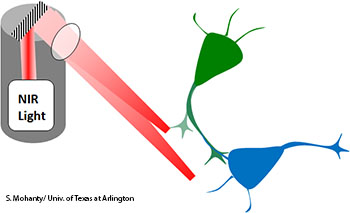
Constructing and manipulating neural circuits is aided by guiding the growth of axons via NIR laser stimulation.
The human brain has more than 86 billion neurons, with trillions of shared connections. In the past few decades scientists have been intrigued by the notion that the repair of axons, the long slender fiber that carries connections for each neuron, may be guided in a non-contact manner by light (PLoS ONE DOI:10.1371/journal.pone.0086292). Previously, guidance of axon growth used the force of optical tweezers or the flow of an optically-driven micromotor. But those methods required intense and tightly-focused light, and were nominally efficient, thus limiting their application for in-vivo manipulation or construction of in-vitro neural circuits.
Now, physics professor Samar Mohanty at the University of Texas at Arlington (U.S.A.) and doctoral candidate Bryan Black have discovered that the axonal growth cone of neurons like those in the cerebral cortex or the retina are sensitive to the minute temperature rises of less than one degree Celsius generated by a low-power (from 1 mW to 50 mW) near-infrared (NIR) laser directed ahead of the advancing growth cone. As temperature is the repulsive cue, the team used the weakly-focused light of a tunable Ti:sapphire laser at 785 nm to guide goldfish retina axons at various depths. In only minutes, retinal ganglion cells grew through turns of up to 120 degrees and over distances reaching 90 µm in response to the heat of a laser directed 5 µm from the leading edge of the advancing growth cone.
The researchers found that the method can work at IR laser powers an order of magnitude lower than that used for prior optical force- and flow-based methods. Further, they reported 100 percent efficacy of the technique in guiding a variety of neurons from mammals to amphibians, unlike the low efficiency of prior methods.
“This technique enables us to build well-defined neuron connections at a basic level,” says Mohanty, “and then develop these neurons into complex neural circuits. This will allow us to carry out optical stimulation and activity-imaging over the whole neural-network.”
Such research may serve as a model for understanding the information processing strategy of neuronal circuits. Future efforts may lead to in-vivo guiding of retina axon growth for repairs of optic nerve hypoplasia and spinal cord injuries.
